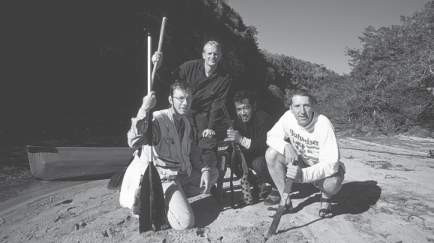The case for Fawcett

Listed below is the basis of our argument that Conan Doyle's The Lost World was influenced by Colonel Percy Fawcett's 1908 expedition over the Serra Ricardo Franco plateau in Brazil. He made the claim in his notes written sometime after the publication of The Lost World in 1912 and before he disappeared in 1925. His son published the notes in 1953, by which time Mount Roraima in Venezuela had already been established as the inspiration for the table top mountain. However the claim gives few details other than the fact he met with Doyle to describe the trip and show him photographs. By tracing Fawcett's expedition we were able to see the geography firsthand and look for similarities in the book.
Geographical similarities
1. The pinnacles: In the book the four adventurers climb onto the plateau by scaling a pinnacle and felling a tree to create a bridge. Fawcett's plateau had many pinnacles around it.
2. The bamboo: In the book the ape men throw their enemies off the plateau down to the base where they are skewered by sharp bamboo. Fawcett's plateau has bamboo at the base.
3. The caves: In the book the adventurers escape the plateau through a network of caves. On Fawcett's plateau we found caves from the top that we were told lead down to the base.
4. Birds that look like dinosaurs: Pterodactyls feature heavily in the book, from the first sighting of a dinosaur to later being attacked by them. The massive jabiru stork as well as sweeping pterodactyl like vultures are all around Fawcett's plateau.
5. Other large animals: Fawcett loved to tell stories of monsters and giant snakes. Many did not take him seriously at the time but we found evidence of massive anacondas along the Rio Verde. We are sure Fawcett would have told Doyle of his discoveries.
6. Zambo: The African character Zambo seems out of place in the book set in South America, but Vila Bela, the town where Fawcett staged his expedition from feels like an African town dumped down in the Amazonian jungle. The town celebrates its African heritage (that came as a result of the slave trade) every year with the Festival of Congo.
7. The rapids: Fawcett spoke much of the rapids along the Verde, that also appear in the book. We found the 15th rapid impossible and likely the place that influenced the description of Challenger loosing all his evidence on his first trip.
8. The map: In the first edition of the book appeared a map that is very similar to the map of Fawcett's expedition.
The link with the explorers
1. While Conan Doyle was possibly a member of the Royal Geographical Society in 1886, he was at the start of a medical career in Hampshire at the time explorer Im Thurn scaled Roraima and spoke of his findings. Whereas we know Doyle was present at Fawcett's talk at the Society just three years before the Lost World was published.
2. There are copies of letters written between Fawcett and Doyle proving that they knew each other.
3. Doyle and Fawcett had a mutual friend called Bertram Fletcher Robinson who most likely influenced the character Malone. Both were London journalist raised in the West Country, fished, hunted, played rugby, were over 6 feet tall and loved a woman called Gladys.
Most likely outcome
While we concede that Conan Doyle probably knew of Roraima by the time he wrote The Lost World and may have modeled some of the descriptions of the plateau on the Venezuelan rock, we believe the far bigger influence came from his more recent conversations with Fawcett about the Serra Ricardo Franco and his trip up the Rio Verde to reach it. That may not be true of the 1925 Hollywood movie, a sensation at the time. It's long distance shots of the the plateau seem to be based on photographs of Roraima. But as Fawcett went missing in the same year the movie came out, and his claim to have been the real inspiration were buried in notes he left behind, there was no one to contradict Roraima's claim. By the time Fawcett's notes were published, Conan Doyle had died and with him had gone any opportunity to corroborate his claims.
It is in one short passage of the book we get the best clue as to the geographical influence when Lord Roxton comments to Malone.
"Now, down here in the Matto Grosso"-he swept his cigar over a part of the map" or up in this corner where three countries meet, nothin' would surprise me... there are fifty thousand miles of waterway runnin' through a forest that is very near the size of Europe. Why shouldn't somethin' new and wonderful lie in such a country? And why shouldn't we be the men to find it out?"
The Serra Ricardo Franco is in Matto Grosso and Roraima stands on a point of the map where Brazil, Venezuela and Guiana meet. It seems that Conan Doyle was taking influence from both.


Today's Top News
- Ukraine says latest peace talks with US, Europe 'productive'
- Economic stability a pillar of China's national security
- Xi taps China's deep wisdom for global good
- New rules aim for platforms' healthy growth
- Chinese web literature grows overseas
- Postgrad exam trend points to thoughtful approach






























